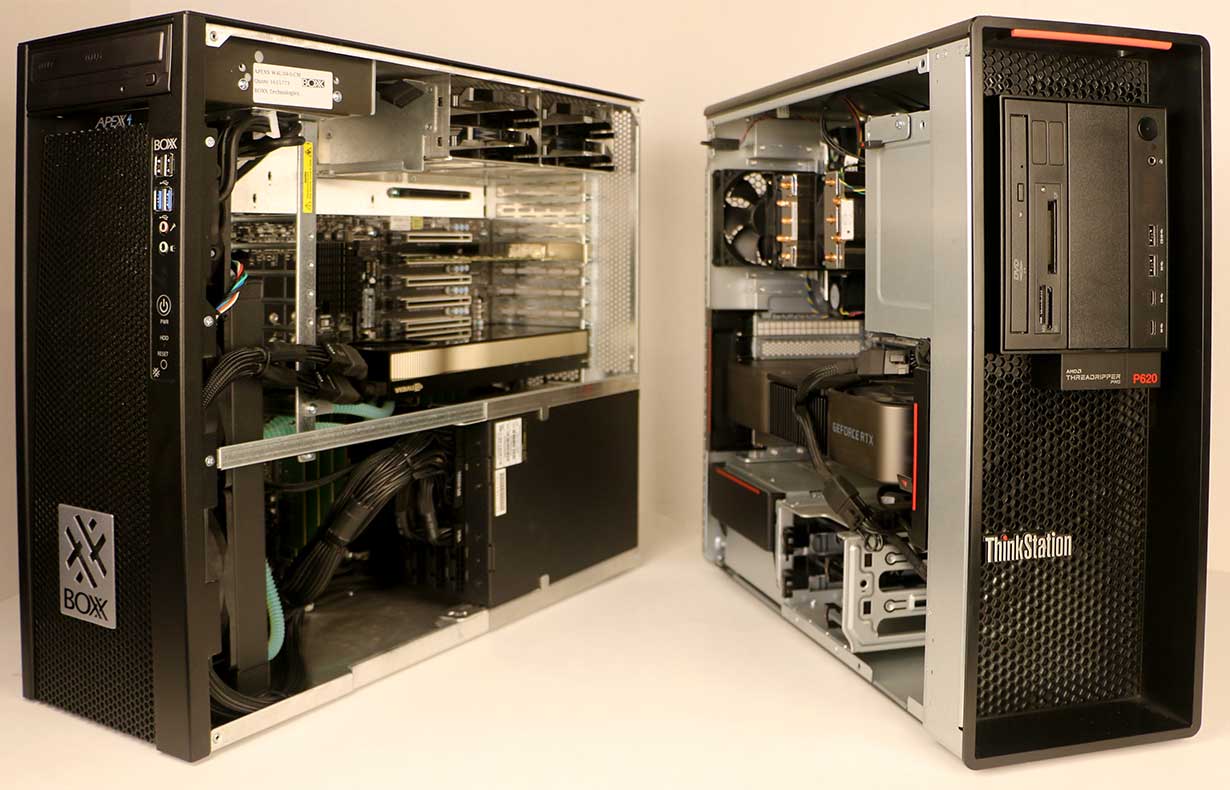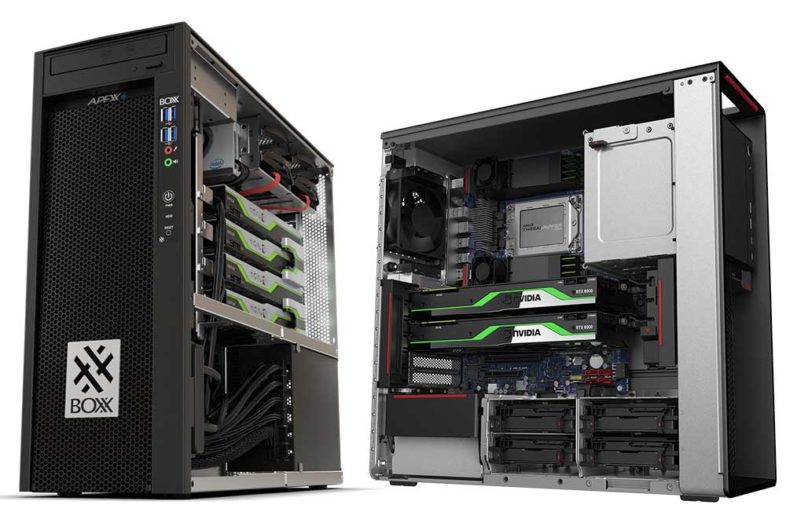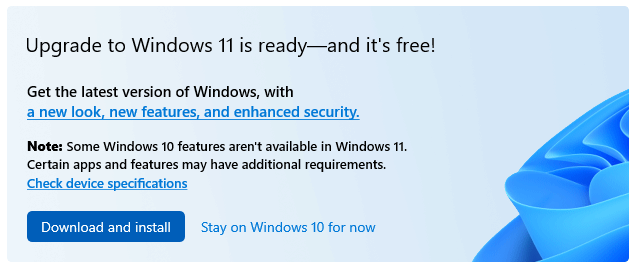I have had the unique opportunity to test the two most powerful single socket workstations available on the market today. Last year’s review of the Lenovo Thinkstation P620 looked at what is still the only new desktop workstation to be released by a major system vendor since 2017. It’s Threadripper Pro 3995WX 64 core processor is the pinnacle of AMD’s Threadripper CPU lineup, and the only Threadripper based system available from a major manufacturer. More recently I have had the opportunity to test out Boxx’s Xeon W 3300 based Apexx Matterhorn workstation. With 38 Cores, 8 channels of memory, and 64 PCIe lanes, the Xeon W 3375 processor is the single socket version of Intel’s newest “Ice Lake” Xeon chips.

Each system design has its strengths, and each system has a few caveats I have discovered. Some of these features and issues are a result of Intel and AMD, and others are from the implementation by Lenovo, and of Boxx, who based their system on a Supermicro motherboard. I have had a year to find all of the peculiarities on the P620, while I have only had the Boxx system for about two months, but I have compiled as much data as I can on each one, to make as thorough of a comparison as possible.
 I have both the GeForce 3090 and A6000 GPUs to test with, as well as a few others, so I was able to swap between them, to see whether the A6000 was any faster than the GeForce, and how much the GPUs impacted the performance measurements. While there are surely cases where the A6000’s professional drivers would offer better performance in certain 3D applications, I did not see a major performance difference between them in any of my tests. This means that:
I have both the GeForce 3090 and A6000 GPUs to test with, as well as a few others, so I was able to swap between them, to see whether the A6000 was any faster than the GeForce, and how much the GPUs impacted the performance measurements. While there are surely cases where the A6000’s professional drivers would offer better performance in certain 3D applications, I did not see a major performance difference between them in any of my tests. This means that:
A: I recommend the cheaper GeForce option for most users
B: I didn’t publish separate benchmarks for both GPUs, since the results were within a couple percent of each other.
The only notable difference I do find, is that the boot problems I have with the AMD system when an 8K display is attached, are solved when I use the A6000 instead of the GeForce card.

The Lenovo system was shipped to me with 32GB of RAM, only utilizing 2 of the 8 memory channels, which is likely capping performance in certain cases. It also has a PCIe 3.0 SSD, as the 4.0 ones were harder to come by back then. The Boxx has 64GB of memory, spread across all 8 channels, which should help it, as well as its PCIe 4.0 SSD which has twice the peak transfer rate for high resolution uncompressed playback tests. So those are some of the configuration based limitations that may impact the results, which might not apply if you configure and buy a new system.
| Benchmark | Boxx Apexx Matterhorn | Lenovo P620 Threadripper Pro |
|---|---|---|
| CineBenchR15 Multi-Core | 6215 | 9649 |
| CinebenchR23 Multi-Core | 40040 | 60120 |
| Puget AE Benchmark | 1773 | 1151 |
| Adobe Media Encoder (HEVC-NvEnc) | 10:03 | 11:02 |
| Adobe Media Encoder (HEVC-10bit Software) | 41:22 | 39:19 |
Both systems play back my 8K assets, and various camera raw files in Premiere Pro in real-time without issue. The Xeon plays back 8K DPXs, but I am confident the Lenovo could too with a PCIe 4.0 SSD. Both have integrated 10GbE ports with support for N-BaseT, although the Boxx system has an extra Gigabit ethernet port. The Boxx system supports IPMI system management, but Lenovo has their own set of system management tools that I am less familiar with.
AMD system has the option for Thunderbolt 3 support via an Add-In-Card while the Intel system does not, due to motherboard limitations. This is ironic considering that Intel created Thunderbolt, and there may be other motherboard choices that do support Thunderbolt, but I can’t find any online.
Here is a point by point comparison of some of the differences:
| Boxx Apexx Matterhorn Xeon W 3375 | Lenovo P620 Threadripper Pro 3995WX |
|---|---|
| 38 Cores from 2.5-4.0Ghz (10nm) | 64 Cores from 2.7-4.2Ghz (7nm) |
| 8 Channels of DDR4-3200 ECC Memory | 8 Channels of DDR4-3200 ECC Memory |
| 64GB RAM (16 Slots, 4TB Max) | 32GB RAM (8 Slots, 2TB Max) |
| 64 PCIe 4.0 Lanes, 7 x16 slots, 4 M.2 Slots | 128 PCIe 4.0 Lanes, 7 x16 Slots, 2 M.2 slots |
| Liquid Cooling, 5 Fans, 1600Watt Power Supply | Air cooling, 5 Fans, 1000Watt Power Supply |
| Requires High Power performance profiles | Throttles up properly in Balanced profile |
| 160-240Watts at idle, 250-420Watts at Load | 240Watts at Idle, 400-500Watts at Load |
| No sleep or hibernate options (Supermicro) | Sleeps and hibernates fine. |
| Runs either A6000 or GeForce 3090 fine | Has boot issues with 8K display on some GPUs |
| Opens apps much faster | Takes over a minute to open Adobe apps |
| Runs smoothly in my experience | Has issues creating folders, zipping files, save AI files |
| No Thunderbolt option (Supermicro) | Has Thunderbolt add in card available |
| Faster AE Benchmarking | Faster Cinema4D Benchmarking |
Neither is a clear winner over the other, and different motherboard manufacturers might deliver different results for certain functionality. The AMD processor is better for Animation rendering, but the Xeon performs better in After Effects. The difference is negligible in Premiere Pro, which is my primary application, so there is not much distinction there.
Although I don’t recommend updating to Windows 11 without a specific reason to make that change, I did look into it for these systems. The Boxx system requires a hardware TPM2.0 card to be installed, in order to support Windows 11. This will of course be included once Boxx starts supporting Windows 11, but didn’t come in my review system. The P620 does support upgrading to Windows 11, and the trick there was to avoid it until I was ready. I put off all of Microsoft’s promptings until I was finished with all my other tests, in case anything went wrong. I usually don’t recommend upgrading an OS, compared to a fresh install, but figured I would give it a try. The operating system updated fine, but I did have some issues in Adobe Media Encoder and a few other apps that weren’t ready for the transition, so I would recommend most professional users stick with Windows 10 for now anyway.
With the Threadripper system, I did have a lot of delays when making new folders and such, but that appears to have been helped by turning off “Show frequently used folders in Quick Access” in File Explorer Options. It still struggles with certain folders, and I haven’t found the cause. Other basic tasks have given me issues, like zip files and Illustrator save actions hanging for 60 seconds intermittently, but then it goes and plays back 8K HDR footage flawlessly from the Kona5 card. I also had lots of problems with the Premiere interface for a month or two, but that turns out to have been caused by a bug in Premiere 15 that only kicked in when a control surface is connected. So the Loupedeck+ console was the change causing that, not the change to an AMD based system. But it is so much quieter and more efficient than my rack server based beast of a home grown workstation, and unlike the server, or the Boxx workstation, it can be put to sleep or hibernated.
If you want a workstation supporting the newest technologies from a larger system vendor, the P620 is the only game in town, being the only workstation from HP, Dell, Lenovo, or Apple, to support PCIe 4.0, among other new features. If you include smaller manufacturers in your search, that opens up options based on Intel’s Ice Lake Scalable Xeons, and AMD Epyc CPUs, but the single socket Xeon W chips are probably a better fit for most workstation users, like those featured in the Apexx Matterhorn.
 If I had to buy a system for myself in that class today, (presumably for PCIe lane reasons) I would buy the Lenovo P620 with the 16 core option, and add a GeForce 3070 if I couldn’t use my existing parts. This is because it is cheaper, and scales down farther, than the Xeon option (and it sleeps, for nearly instant boot to get back to work). But many Adobe users, would probably be better served by a system a few steps down from these ones here. The first step down, would be the standard Threadripper processors, with half the channels of RAM and PCIe lanes of the Pro series. This actually isn’t a huge cost savings, because Lenovo has put the Threadripper Pro into a well designed and reasonably cost effective package. Below Threadripper there are Core-X based HEDT systems from Intel. These are placed firmly between these systems and consumer level options, but this platform (X299) was released in 2017, and lacks basic features like PCIe 4.0, among other things. I have set up HP Z4 systems that have worked well for clients who edit 4K projects, but that was years ago. Below that, we have consumer level Core i9 and Ryzen systems, that now feature up to 16 cores, and 128GB RAM. These probably could meet the needs of more users than you would expect.
If I had to buy a system for myself in that class today, (presumably for PCIe lane reasons) I would buy the Lenovo P620 with the 16 core option, and add a GeForce 3070 if I couldn’t use my existing parts. This is because it is cheaper, and scales down farther, than the Xeon option (and it sleeps, for nearly instant boot to get back to work). But many Adobe users, would probably be better served by a system a few steps down from these ones here. The first step down, would be the standard Threadripper processors, with half the channels of RAM and PCIe lanes of the Pro series. This actually isn’t a huge cost savings, because Lenovo has put the Threadripper Pro into a well designed and reasonably cost effective package. Below Threadripper there are Core-X based HEDT systems from Intel. These are placed firmly between these systems and consumer level options, but this platform (X299) was released in 2017, and lacks basic features like PCIe 4.0, among other things. I have set up HP Z4 systems that have worked well for clients who edit 4K projects, but that was years ago. Below that, we have consumer level Core i9 and Ryzen systems, that now feature up to 16 cores, and 128GB RAM. These probably could meet the needs of more users than you would expect.
Looking upwards, the Boxx solution supports four full double wide GPUs, plus a sync card, which clearly exceeds the Lenovo, if your application can utilize that much processing power effectively. So the Boxx clearly scales higher, and can be much “faster” than the Lenovo, if you add enough GPUs. That helps in maximizing potential performance, before you need to jump to the next tier with a dual socket system, which increases the price even more substantially, but the Lenovo design might appeal to a broader set of users. There are a much wider variety of workstation options available than there used to be, but you really need to understand your own processing needs, based on your target applications and workflows, to find the “right” solution for your needs. These systems are clearly the “fastest” single socket systems available today, but they aren’t necessarily the “best” solution for every user.


